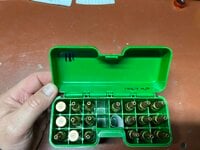So recently I loaded up 4 boxes of 7mm-08 for a buddy with a load that's been tested extensively to be good across several of their rifles. After doing so I decided to check the brass weight on fired cases since he recently bought a batch of PPU brass.
I was shocked that the PPU weighed 13 grains heavier than his old blue bag Winchester brass. To me, that was a lot. Did a h20 capacity measurement between the 2 cases and it is only 3/4 of 1 grain difference. Which will equate to about 35 fps. Not near as big of a deal as I thought it would be for that large of a difference between brass. I already did accuracy tests loading that PPU brass and pressure is not an issue as it is a middle of the road charge.
So weighing out brass and culling out brass that is 3-4 grains variance in the same head stamp would seem almost futile for any type of hunting load. Interestingly he has both Remington and Winchester brass fired through the same rifle, and they are only around 1 grain difference on the few I checked. Remington being slightly heavier.
I was shocked that the PPU weighed 13 grains heavier than his old blue bag Winchester brass. To me, that was a lot. Did a h20 capacity measurement between the 2 cases and it is only 3/4 of 1 grain difference. Which will equate to about 35 fps. Not near as big of a deal as I thought it would be for that large of a difference between brass. I already did accuracy tests loading that PPU brass and pressure is not an issue as it is a middle of the road charge.
So weighing out brass and culling out brass that is 3-4 grains variance in the same head stamp would seem almost futile for any type of hunting load. Interestingly he has both Remington and Winchester brass fired through the same rifle, and they are only around 1 grain difference on the few I checked. Remington being slightly heavier.





